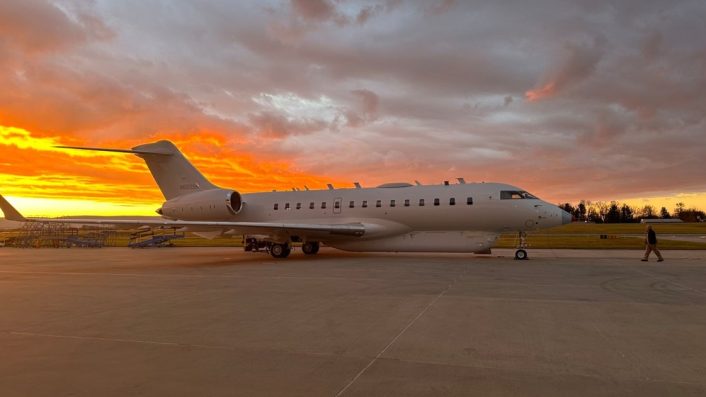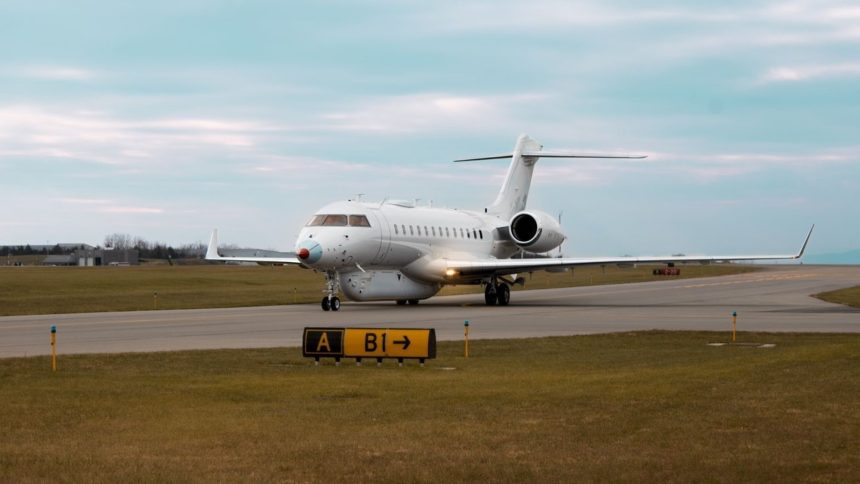The completion of the Flight Performance Handling & Qualification testing is a key milestone in proving the jet’s airworthiness with consistent performance for the full flight envelope.
Sierra Nevada Corporation’s (SNC)’s RAPCON-X aerial intelligence, surveillance and reconnaissance (A-ISR) aircraft successfully completed its initial Flight Performance Handling & Qualification flight testing, the company announced on May 8, 2025. The firm said the tests demonstrated that the aircraft performed “well” and within the stipulated safety features after the RAPCON-X modifications.
SNC modified a Bombardier Global 6500 into the Rapidly Configurable To Any Mission-X (RAPCON-X) for the U.S. Army’s Theater Level High-Altitude Expeditionary Next Aerial-Signals Intelligence (ATHENA-S) program. The Bombardier Global 6500 jet is also the aircraft of choice for the U.S. Army’s broader High Accuracy Detection and Exploitation System (HADES) program – within which ATHENA-S falls.
The RAPCON-X aircraft flew its maiden flight on Nov. 22, 2024. The aircraft is intended to fly in support of future contractor-owned, contractor-operated (COCO) service customers such as the U.S. Army.
“Achieving Flight Performance Handling Qualification (FPHQ) is a significant milestone toward proving the aircraft’s airworthiness by validating consistent performance throughout the full flight envelope to ensure safety and reliability” the company said.

SNC is expected to conclude the flight testing’s final phase for both of its RAPCON-X aircraft this summer, while targeting to deliver the Contractor-Owned Contractor Operated ISR aircraft in the fourth quarter of 2025. SNC conducted the modification after being contracted by the U.S. Army in 2023 to provide two COCO aircraft.
This was part of a prototyping effort ahead of fielding a new high-altitude ISR fleet. The conversion work was carried out at SNC’s aircraft integration facilities in Hagerstown, Maryland, with the aircraft being directly acquired by the company, while the government provided most of the electronic and communications intelligence systems.
We completed flight performance testing of our RAPCON-X Bombardier Global 6500 jet! This Flight Performance Handling Qualification is a key milestone in proving the jet’s airworthiness with consistent performance for the full flight envelope. Learn more: https://t.co/15Ex7QhebH. pic.twitter.com/F92eu3rAd2
— Sierra Nevada Corporation (@SierraNevCorp) May 8, 2025
RAPCON-X
According to SNC, the RAPCON-X is a highly versatile multi-domain ISR platform which, in its baseline configuration, can collect and process signals intelligence, electro-optical reconnaissance and ground moving-target signatures. The proprietary SNC TRAX software also connects all net-enabled platforms in the battlefield.
The capability is crucial in highly contested and complex battlespaces, where the “RAPCON-X represents the future of ISR, delivering unparalleled capabilities to our military and intelligence partners.” The program is in response to a growing need to seamlessly integrate air, land, sea, cyber, and space data for presenting a collective, overall theatre-wide picture enhancing decision-making.
RAPCON-X’s rapid configurability enables the carrier Global 6500 jet to be swiftly modified by swapping on-board equipment to match tactical needs – particularly for higher altitudes and longer endurance. The company also says RAPCON-X’s technology can be scaled to other aircraft types, including the Bombardier Challenger 650 and King Air 350ER.
RAPCON-X completed its first flight yesterday! This milestone is a significant step forward for the A-ISR platform, which has been selected for the U.S. Army’s Theater Level High Altitude Expeditionary Next Airborne ISR (ATHENA) project. #ICYMI #TeamSNC https://t.co/lV6v6kT5Rs pic.twitter.com/OMrHM0AQhh
— Sierra Nevada Corporation (@SierraNevCorp) November 22, 2024
“RAPCON-X provides a disruptive asymmetric advantage to combatant commanders,” SNC’s executive vice-president Tim Owings said in the company’s release. Executive vice-president for business development Tim Harper explained how “Long-range, deep sensing is foundational” in the modern battlespace to deter competitors and adversaries, and RAPCON-X will provide an “asymmetric advantage” for ISR missions by offering “speed, range, endurance and altitude for the deep sensing U.S. soldiers need to outpace our near-peer adversaries.”
The company says the RAPCON-X offers 12 hours of mission endurance time, a service ceiling of 45,000 feet and a 6,000 nautical mile ferry range. Besides Bombardier, SNC’s other partners in the RAPCON-X team include ThinKom Solutions, Inc. and Leonardo USA.
Flight Performance Handling & Qualification
The Flight Performance Handling & Qualification testing for RAPCON-X saw SNC and partner Bombardier Defense testing the “flight handling characteristics of the modified aircraft,” with a “full regime of flight maneuvers to validate its airworthiness and safety.” The RAPCON-X modifications made to the Global 6500 did not affect the “Reduced Vertical Separation Minimum (RVSM) capability” of the jet, and it “continues to perform well,” the SNC release added.

RVSM is a technology that allows aircraft to fly with a smaller vertical separation between them at higher altitudes, a critical requirement of A-ISR missions. The bulge on the ventral side, and an array on the spine above the cockpit, housing the concerned sensors, could be seen in the images that captured the aircraft while taking off and taxiing.
“The RAPCON-X flight testing program was completed per plan, safely and efficiently – a testament to the ongoing seamless collaboration between Bombardier Defense and SNC. The performance and handling qualities were confirmed to be as predicted,” said Steve Patrick, vice president of Bombardier Defense. “The partnership with SNC to execute its RAPCON-X solution has clearly demonstrated Bombardier Defense’s expertise, experience and flexibility in delivering solutions collaboratively with our partners to support our customers’ ISR modernization efforts.”
ARTEMIS, ATHENA and ARES
The Army began shaping the Multi-Domain Sensing System (MDSS) High Accuracy Detection and Exploitation System (HADES) program in 2020. This was intended to replace the four-decade old legacy turboprop aircraft fleet of RC-12X Guardrail, MC-12S Enhanced Medium Altitude Reconnaissance and Surveillance System, and EO-5C Airborne Reconnaissance Low aircraft.
HADES’ prototypes will be the first Army-owned large-cabin business jets utilized for aerial ISR platforms.
SNC’s RAPCON-X family of systems is a rapidly configurable A-ISR solution. Open architecture is the common thread across all RAPCON-X offerings, enabling the superior range, endurance & payload capability needed to fill critical gaps throughout PACOM. #Avalon2025 #TeamSNC pic.twitter.com/Wz9HVaiS4n
— Sierra Nevada Corporation (@SierraNevCorp) March 24, 2025
HADES aims to provide the service with a fleet of ISR aircraft with SIGINT (signal intelligence), SAR/MTI (synthetic aperture radar/moving target indicator) and additional capabilities. In preparation for HADES, the Army demonstrated and deployed operationally other COCO ISR jets as part of the Airborne Reconnaissance and Targeting Multi-Mission System (ARTEMIS) and Aerial Reconnaissance and Electronic Warfare System (ARES) programs.
Selected for the Army’s ATHENA project, SNC’s RAPCON-X family of systems is a rapidly configurable A-ISR solution. Open architecture is the common thread across all RAPCON-X offerings, enabling the superior range, endurance & payload capability for any mission. #24Summit pic.twitter.com/u1ZZUWgBal
— Sierra Nevada Corporation (@SierraNevCorp) April 24, 2024
These evaluate sensors and collect data at the altitudes, speed, and ranges that HADES is expected to perform and inform the program’s requirements. ARTEMIS has been operational since 2020, with deployments both in the Indo-Pacific and Europe. The Army valued the faster deployment capability of the platform, based on the Challenger 650, and the ability to travel anywhere in the world within 24 hours, in addition to the higher performance compared to a turboprop.
ARES, also based on the Global 6500, was deployed to the Indo-Pacific in 2022. The Army said that, in addition to a performance increase, ARES is closer to the HADES project’s long-term goals.









